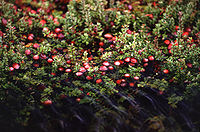
Photo from wikipedia
Background: Central obesity is defined as the excessive fat tissue located in abdominal region accompanied by systemic inflammation, which drives to cardiovascular disease. Flavonols are antioxidative agents present in food.… Click to show full abstract
Background: Central obesity is defined as the excessive fat tissue located in abdominal region accompanied by systemic inflammation, which drives to cardiovascular disease. Flavonols are antioxidative agents present in food. The aim of this study was investigating the relationship between dietary flavonols intake and central obesity. Methods and results: 80 participants (40 central obese and 40 healthy controls) were administered a food frequency questionnaire dedicated to flavonols intake assessment. Body composition was measured with bioelectrical impedance analysis. The analysis showed significant differences between central obese participants and healthy controls in total flavonol (p = 0.005), quercetin (p = 0.003), kaempferol (p = 0.04) and isorhamnetin (p < 0.001) habitual intake. Among central obese participants, there was a moderate inverse correlation between fat mass (FM) and total flavonol (R = −0.378; 95% CI: −0.620 to −0.071; p = 0.02), quercetin (R = −0.352; 95% CI: −0.601 to −0.041; p = 0.03), kaempferol (R = −0.425; 95% CI: −0.653 to −0.127; p = 0.01) and myricetin intake (R = −0.352; 95% CI: −0.601 to −0.041; p = 0.03). BMI was inversely correlated with total flavonol (R = −0.330; 95% CI: −0.584 to −0.016; p = 0.04) and quercetin intake (R = −0.336; 95% CI: −0.589 to −0.023; p = 0.04). Waist circumference was inversely correlated with total flavonol (R = −0.328; 95% CI: −0.586 to −0.009; p = 0.04), quercetin (R = −0.322; 95% CI: −0.582 to −0.002; p = 0.048) and myricetin intake (R = −0.367; 95% CI: −0.615 to −0.054; p = 0.02). Among flavonols’ dietary sources, there was an inverse correlation between black tea consumption and FM (R: −0.511; 95% CI: −0.712 to −0.233; p < 0.001) and between coffee and waist circumference (R: −0.352; 95% CI: −0.604 to −0.036; p = 0.03) in central obese participants. Conclusions: The higher flavonol intake could play a protective role in abdominal obesity development. What is more, total and selected flavonol dietary intakes are inversely correlated with the parameters used for obesity assessment in central obese participants. The habitual consumption of products rich in flavonols, mainly tea and coffee, could possibly have a preventive role in abdominal obesity development.
Journal Title: Nutrients
Year Published: 2022
Link to full text (if available)
Share on Social Media: Sign Up to like & get
recommendations!